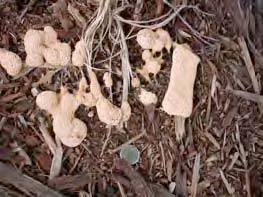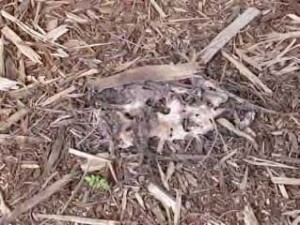Download PDF (PLPA-107)
“There is yellow foam like stuff in playground. It is going to hurt the kids?”
“Urgh!!! There is something that looks like dog vomit on my mulched flower bed!!!”
“There is this ugly blob in my flower bed, and it was somewhere else the next day. Can it move?”
CAUSAL AGENT
These are some of the questions that are asked concerning slime mold. Slime molds belong in the phylum Myxomycota in the kingdom Protista. They are not a true fungus. These organisms exist in nature as a “blob” (plasmodium), similar to a amoeba. And they engulf their food, mostly bacteria. The slime mold that typically appear on mulches are from the genus, Fuligo.
The brightly color blobs usually appear and may spread around mulched beds when there is high humidity and relatively warm temperatures. In Texas, we typically hear of slime molds in the spring and occasionally in the summer in highly irrigated shade areas. Slime mold can appear to be bright yellow to red. As they begin to dry out, these colors fade to brown and tan. Breaking up the dried blob, you may notice a dark brown to black core – the spores. Slime molds are not known to be a danger to human or animals.
CONTROL
Chemical treatment is not warranted for this problem. These organisms are very sensitive to the environment. The best approach to controlling slime mold is by modifying the environment. Slime molds do not survive well in dry conditions. We cannot control the rains, but we can carefully manage our irrigation systems to reduce the amount of wetness on the surface. You can also use a rake or even use a stream of water to break up the slime mold. This will encourage the drying out of the slime mold and remove the unsightly “vomit”.
Some people consider the slime mold to be a beneficial organism in that it helps in the decaying process of the mulch and may also play a role in competing against some soilborne plant pathogens.
Prepared by Dr. Kevin Ong
Assistant Professor and Extension Urban Plant Pathologist
Texas AgriLife Extension Service; The Texas A&M University System
April 21, 2005 (rev. 012408)
The information given herein is for educational purposes only. References to commercial products or trade names are made with the understanding that no discrimination is intended and no endorsement by Texas AgriLife Extension Service personnel is implied.
Educational programs of the Texas AgriLife Extension Service are open to all people without regard to race, color, sex, disability, religion, age, or national origin.
The Texas A&M University System, U.S. Department of Agriculture, and the County Commissioners Courts of Texas Cooperating

